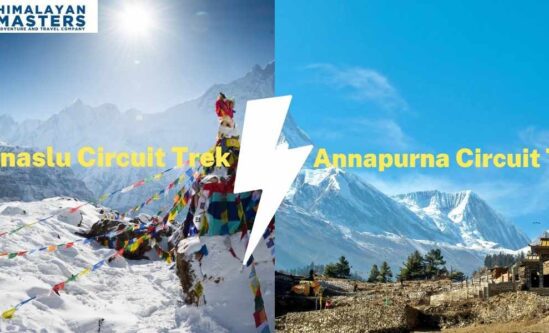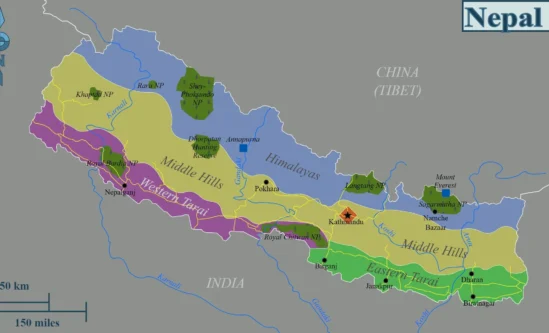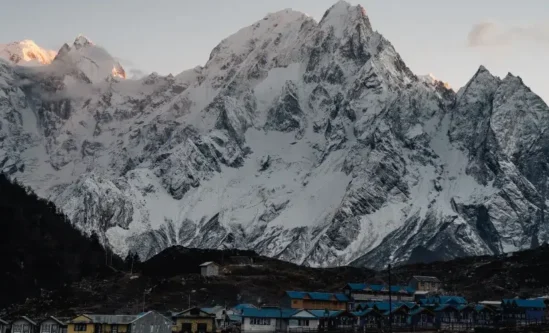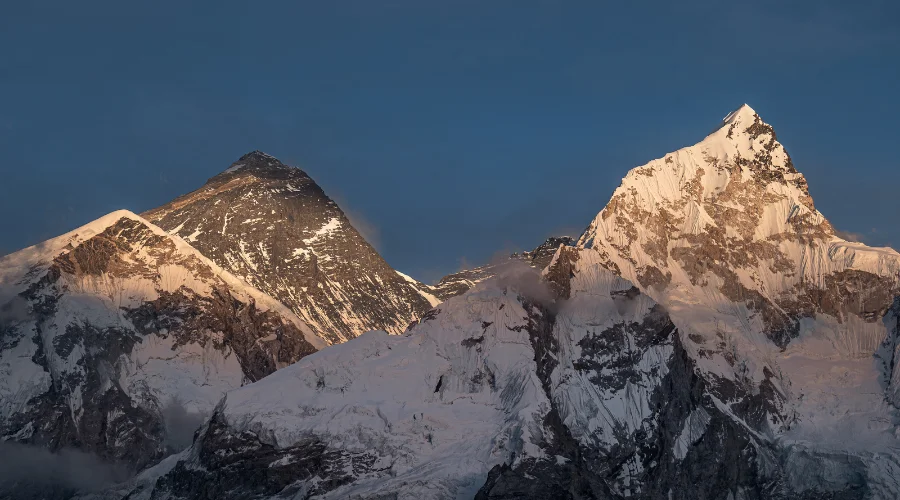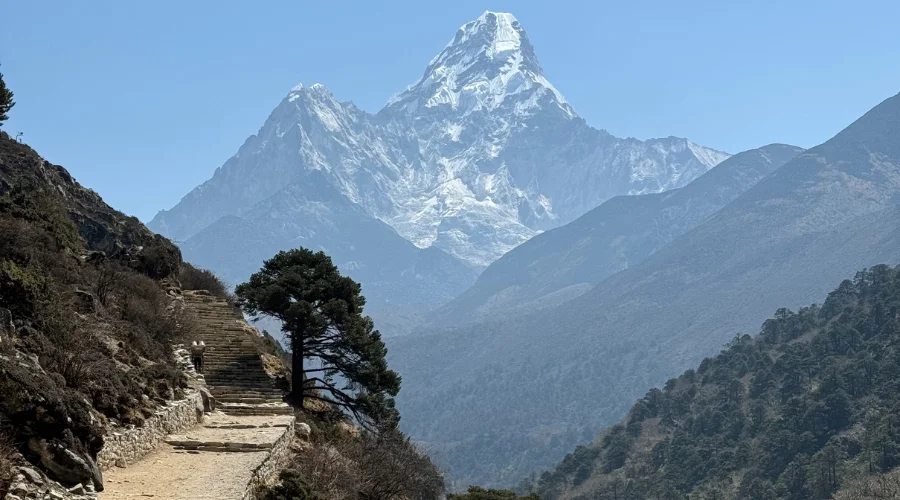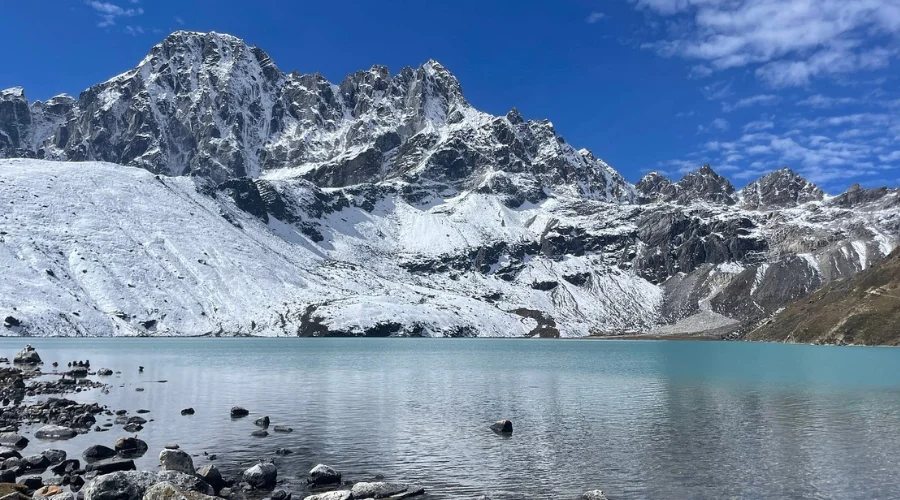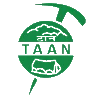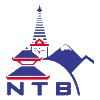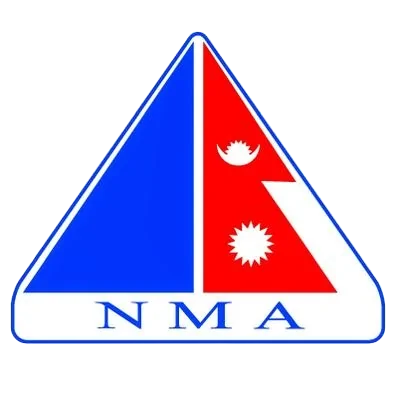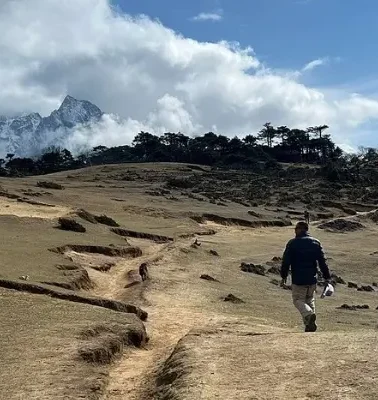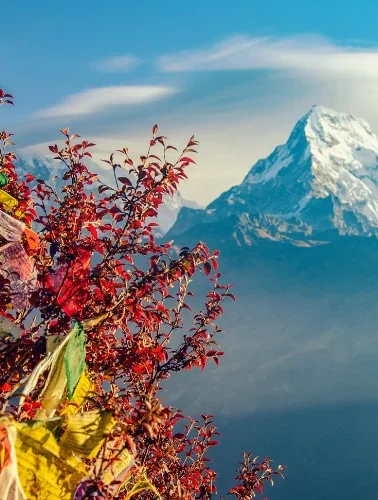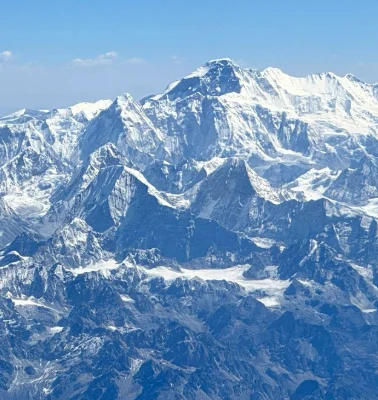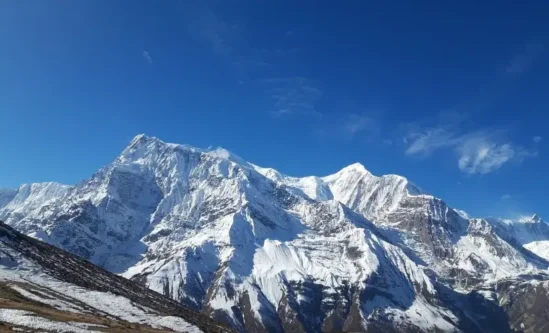
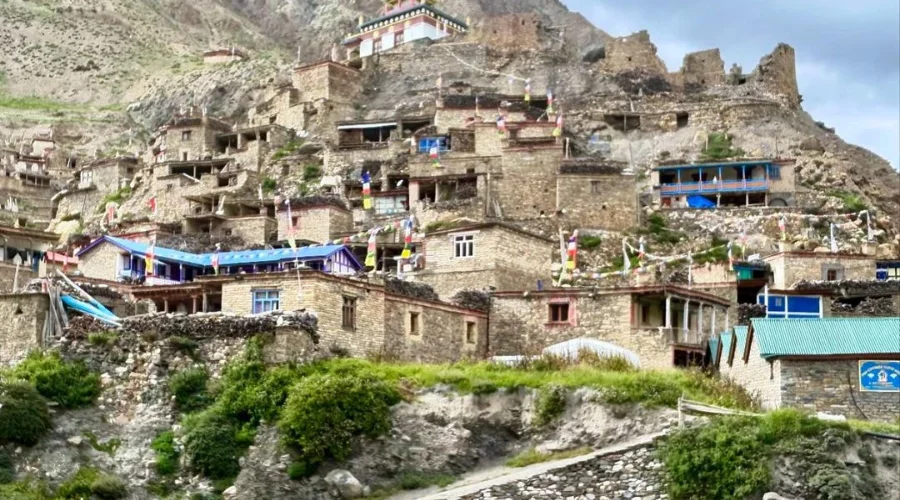
- TRIP DURATION
- 09 Days
- MAX. ALTITUDE
- 5320 m/17454 ft.
- TRIP GRADE
- Moderate
- LODGING
- Guest House/Tea House
- BEST SEASON
- Springs and Autumn
- MEALS
- Breakfast, Lunch & Dinner
- COMMUNICATION
- Wi-Fi/Local SIM Card
- PER DAY WALK
- 5 to 7 Hours
Nar Phu Valley Trek – 9 Days Itinerary
Nar Phu Valley is one of Nepal’s untouched areas is the remote and shadowy, deep inside the Annapurna range. It is in Manang, and its surrounding region are now known as the Nisyang Valley.
Nar and Phu villages came to the government’s attention only after they saw the washing down clothes flowing down the Nar Khola. Because of their curiosity, they discovered this mysterious trek.
In 2002, Nar Phu was opened to foreigners, allowing travellers to witness the unspoiled Himalayas, age-old Tibetan customs and exciting high-altitude experiences. It’s not only about exploring the land; it’s also about uncovering a hidden world.
You start your trek in Koto, which is just a short walk from Chame, the headquarters of the Manang district. The next part of the trail goes through a tightly curved ravine in the cliffs, ending at Meta, a small place that means “below” in the local language.
From above, Meta appears to serve as a level space that the Nar villagers use for farming various crops each season. After trekking deeper into the valley, trekkers walk over Mahendra Pul, a high-suspension bridge that connects Meta to Nar Phedi.
This is home to the well-known Sate Gompa, which was built by Karma Thilen Lama, who is said to have founded 108 monasteries in the Himalayas. This spiritual landmark is the source of the valley’s deep religious history.
As you go on, the Nar Phu village majesties come into view. These settlements are where you can see and experience ancient Tibetan customs.
During Baisakh and Asar, most people from Phu and surrounding villages go to high-altitude meadows such as Namgyal Kharka, Kicho Lek, Pisang Lek and Yak Kharka to collect Yarsagumba.
Many villages look deserted, as their women, children and older residents have moved to better-off towns such as Pokhara and Kathmandu.
In the local language, the Nar village is called Chuprung. It features closely packed mud homes and a gate built to keep animals from straying. When you step just outside the village, you may notice Jimmu (Himalayan onion) being grown, making the landscape more colourful.
The language known as the Nar-Phu dialect is spoken by both the Narten of Nar and the people of Phu. These villages maintain their way of life thanks to houses with stone foundations, colourful flags, and age-old traditions.
The Nar Phu Valley Nepal does not feature luxury and crowds. It benefits those who want a sense of quiet, deeper reflection, and spirituality. As you trek through narrow canyons, over snow-covered glaciers, and climb Kang La (5,320m), you’ll be close to nature and discover many spectacular landscapes.
A trek through the Nar Phu Valley gives travellers one of Nepal’s most rewarding experiences that no one will forget.
Nar Phu Valley Trek Facts
- District: Manang
- Trail Opened: 2003 A.D. (for foreign trekkers)
- Difficulty Level: Moderate
- Trek Duration: 9 days
- Per Day Walk: 5-7 hours
- Beginning/Ending Point: Kathmandu, Nepal (1400 m)
- Trek Beginning Point: Koto, Manang (2600 m/8530 ft.)
- Trek Ending Point: Ngawal, Manang (3660 m/12007 ft.)
- Trek Distance: Approximately 70 km/43 miles
- Total Driving Hours: 20 hours
- Maximum Altitude: Kang La Pass (5320 m/17454.07 ft)
- Permits: Annapurna Conservation Area Permit (ACAP) and Nar Phu Special Permit
- Mode of Transportation: Jeep or Bus to Koto
- Best Time to visit Nar Phu: Autumn (September to November) and Spring (March to May)
Top Highlights of Nar Phu Valley
- Nar and Phu are two separate medieval villages.
- Remote and less crowded trekking route, offering a peaceful experience away from mainstream trails.
- Stunning views of Annapurna I, II, III, and IV, and Tilicho Peak.
- Traditional Tibetan-influenced Nar and Phu villages with unique cultures and ancient monasteries.
- Ancient caves and hermitages used by monks for meditation.
- High-altitude desert landscapes combined with lush green valleys.
- Crossing the Kang La Pass (5,320 meters) with breathtaking panoramic mountain views.
- Rich biodiversity, including sightings of Himalayan wildlife like blue sheep and snow leopards (rare).
- Opportunity to explore the sacred Phu Monastery, a spiritual centre for locals.
- Dramatic changes in landscape from alpine forests to barren rocky terrains.
- Authentic experience of the lifestyle of the Indigenous Nar and Phu people.
- Chance to visit the isolated village of Phu, known for its ancient architecture and preserved culture.
- Encounter traditional Tibetan prayer flags, mani stones, and chortens along the trail.
- Stunning sunrise and sunset views over the Himalayan peaks from high camps.
- Crystal-clear mountain streams and natural springs along the trek.
- Experience the fusion of Tibetan and Nepalese cultures in remote Himalayan settings.
History of Nar Phu Valley
The Nar Phu Valley owes its early history to Tibetan migrants. Many centuries ago, people from Tibet crossed the Himalayas to the valley, hoping to raise their cattle peacefully.
Because of Tibetan Buddhist settlers, that era’s culture, language, and architecture continue to shape the valley today.
Due to being far from civilisation and having difficult terrain, the place avoided outside influences for many years.
Chame residents noticed a group of oddly cut clothes flowing down the Nar Khola River, which led to the government’s discovery of Nar and Phu villages. As a result, an investigation revealed that people had built villages in the mountains.
Even though it had been in Nepal for several centuries, foreigners could not access the valley for sightseeing and trekking until 2002. Because people built in the valley late, it retained its actual character and kept its history and culture untouched.
Nar Phu Language
Only people in the remote Nar and Phu villages in upper Manang, Nepal, speak the Nar Phu language. Like the Tibetan-influenced dialects, it is a member of the Tibeto-Burman family.
Since only a very small number of individuals speak it natively, the Language Commission considers it a critically endangered language in Nepal.
In that same year, the commission placed Nar Phu among eight new minority languages in danger of becoming extinct, alongside the Rana Tharu, Chum Nubri and Poike languages.
The daily use of the Nar Phu language is declining as more young people migrate to cities and use Nepali and English instead. While old villagers care to use the dialect at home, younger people are more apt to use common languages at school and at work.
Culture and Wildlife in Nar Phu Trek
But the Nar Phu Circuit Trek is more than a treasure in culture. Tibetan influences among the people have kept traditions alive for centuries. Buddhism guides festivals, rituals, and daily life events; thus, it is a beautiful, spiritual valley. Colourful prayer flags, monasteries, and traditional homes portray this heritage.
Wildlife in the Nar Phu Valley is diverse and unique in its way. The number of species comprises Himalayan blue sheep, snow leopards, and many birds. While trekking through lush forests of fir, coniferous, and alpine meadows, one rarely can witness rare species of wild animals.
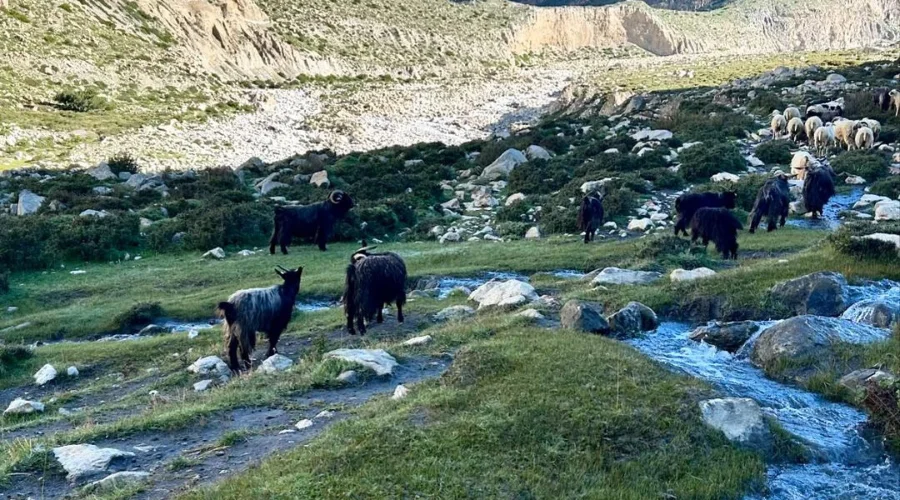
A Typical Day on the Nar Phu Valley Trekking
A typical day on the Nar Phu Valley Trek begins early in the morning with breakfast at the lodge, often featuring local dishes. Trekkers usually hike for about six hours, although some days may extend to eight. Especially when crossing high passes like Kang La Pass.
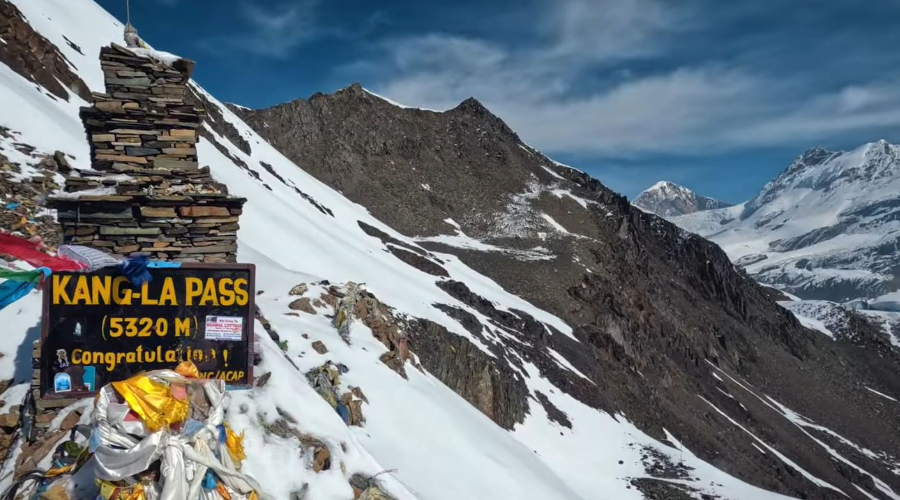
Lunch is typically enjoyed on the trail, consisting of simple meals such as noodles or rice. It helps trekkers to refuel while immersing in the stunning natural surroundings. Nar Phu Village also includes opportunities for cultural experiences, such as attending evening prayers at monasteries and sharing meals with local villagers, enriching the journey.
Acclimatization days are included in the Nar Phu Valley Trek itinerary, particularly after reaching higher altitudes like Phu, where trekkers can explore the village and nearby sites to adjust to the elevation and prevent altitude sickness.
Trip Grade: Fitness Level, Medical, & Health
Nar Phu Trek requires trekkers to be in good physical shape. Most days, your hike involves several hours on rough and uneven mountain trails. You’ll usually climb steeper areas and pass Kang La Pass, which stands over 5,320 meters above sea level. Having a fair level of fitness will allow you to go on the hike without undue exhaustion or injuries.
Working out with cardio movements such as hiking, jogging, or cycling just before your trip will benefit you when you are walking a lot. Keep in mind that the hike requires both physical power and stamina.
Being at a high altitude is an important consideration on this trek. Because Nar Phu Valley is so high, there is a real possibility of altitude sickness. You should move forward gradually, rest when needed, and keep your body hydrated.
Most Nar Phu trekking routes include a few days for your body to adapt to altitude. If you notice headaches, dizziness, or nausea, it may be a sign of altitude sickness.
Always travel with simple medications and discuss the effects of altitude with your doctor. Also, remember to pack a first aid kit for handling small emergency issues.
There are not many medical services available in the Nar Phu region, and there are no hospitals or clinics on the region. Getting out by helicopter is a choice during emergencies, but it costs a lot and is only possible in good weather. For this reason, it is vital to pay attention to your own health and prevent issues.
People who plan to hike at high altitudes should have emergency evacuation insurance. Having what you need to treat simple medical issues and packing your supplies properly is the duty of a responsible trekker.
Know More About Nar Phu Valley Trek Preparation
Nar Phu Valley Trek Cost
Nar Phu Valley Trek costs $995 per person, with essential services like permits, food, accommodations, and guides. It will cover everything listed in the trek list, which is already mentioned in our include/exclude section.
Himalayan Masters provide one of the best deal at this price with the best services. The Nar Phu Valley Trek package cost might fluctuate sometimes due to some unseen circumstances like extra days or some incidents.
Nar Phu Valley Trek Permit
Nepal’s government has kept Nar and Phu Valley a restricted region to preserve this place’s local culture and tradition. It would be best to have a specialized Nar Phu Valley Trek Permit in the Nar and Phu valleys. Your trekking agency in Nepal issues the Nar Phu Valley Restricted Area Permits.
The Nar Phu permit cost U$100 per week per person. If you stay longer, you must pay $10-$15 daily. Independent trekkers cannot issue the Nar Phu Valley permit- a licensed guide must accompany you.
Also, a team of two trekkers can only issue the Nar Phu Valley Trek Permit. Next, you have Annapurna Conservation Area Project (ACAP) permits.
Know More About Nar Phu Valley Trek Permits and Paperwork
Benefits of Trekking Nar Phu Village with Himalayan Masters
- Nar Phu Trek itinerary customization as per your preferences and needs.
- Get trek certificates after the successful trek completion.
- Online as well as offline trek briefing.
- 24/7 communication on different channels like WhatsApp, Facebook, Instagram, and Viber.
- Best licensed local guides with huge knowledge about the routes.
- Promotes sustainable tourism and respects local environments.
- Easy booking process and straightforward.
- Competitive pricing with no hidden charges, great value for money.
- From permits, accommodation, meals, to airport pickups, everything is arranged for you.
- Positive feedback from past trekkers across platforms like TripAdvisor and Google.
Important Things to Remember for the Nar Phu Trek
- Take enough water and snacks along with you.
- Dress in layers as the weather changes.
- Respect the customs and traditions of the place.
- Carry Nar Phu Valley Trekking permits should always be with you.
- Take eco-friendly, biodegradable products.
- Pay respect to the trail signs and guides.
- Trek at a reasonable pace.
- Be prepared for altitude changes.
Best Places to Acclimatize during Nar Phu Trek
The Nar Phu Valley Trek itinerary has one day acclimatization day where we have many options to visit. If we go as per our itinerary, we will hike up to the Himlung Himal Base Camp but there are many more places that we can explore during the optional rest day.
Tashi Lhakhang Gompa is another best option for the rest day. This monastery is really beautiful where you will explore with the guidance of nun. The monastery has prayer halls and library also.
The monastery is listed out of the 108 world’s great Buddhist Monasteries. Tashi Gompa is a side trip to Milarepa’s Cave from Braga.
The Challenging Journey of Kang La Pass
The Kang La Pass at an altitude of 5,320 meters provides one of the greatest and toughest challenges during a trek in the Nar Phu Valley. During this part of the adventure, you really sense the wild unrestrained beauty of the Himalayas.
It usually takes hours to get to the top, so guides often start the ascent before sunrise in the freezing dark. At the highest point, you get one of the best views you see Annapurna II, Gangapurna and Tilicho Peak up close and clear.
More than being physical, crossing the pass is a great achievement and leaves you full of proud feelings. Because there is often strong wind and snow in this region, you need to stay prepared.
When the summit is done, the path descends to Ngawal, where the Annapurna Circuit starts again. What makes Nar Phu Valley unique among Nepal’s trekking regions is this dramatic crossing.
Nar Phu Valley Trek Distance
The total distance of the Nar Phu Valley Trek varies slightly depending on the exact route and side trips, but it generally covers around 70 to 100 kilometers (43 to 60 miles).
If you’re combining it with parts of the Annapurna Circuit, the distance can extend even more. The trek usually takes around 12 to 15 days, including rest days and acclimatization.
Out of the total distance, approximately 65 to 75 km (40 to 47 miles) are pure trekking trails, where you walk through remote valleys, forests, and high passes.
The rest of the distance includes rough roads suitable for jeeps and buses, especially in the Kathmandu to Koto and from Ngawal/Manang to Besisahar sections, which are usually covered by vehicle.
The longest trekking day is usually the day when you cross Kang La Pass, which can take 8 to 10 hours of walking depending on your pace. The shortest day might be the exploration day around Phu or Nar, where you only walk for about 3 to 4 hours.
Mountains Seen from Nar Phu Trek
The Nar Phu Valley trek offers breathtaking views of some of the highest and most iconic Himalayan peaks. As the Nar Phu Trek route moves through narrow gorges, open alpine valleys, and high passes, so, trekkers are treated to spectacular mountain panoramas.
Here are the major peaks you can see during the Nar Phu trek and the best viewpoints for each:
- Dhaulagiri (8,167 m/26,795 ft): Seen from Kang La Pass, especially on clear days
- Annapurna II (7,937 m/26,040 ft): Visible from Meta, Nar Phedi, Nar village, and Kang La Pass.
- Himlung Himal (7,126 m/23,379 ft): Best seen from Phu village and near the monastery above Phu.
- Gangapurna (7,455 m/24,457 ft): Visible from Nar village and during the descent from Kang La Pass.
- Pisang Peak (6,091 m/19,983 ft): Seen clearly while descending from Kang La Pass toward Ngawal.
- Tilicho Peak (7,134 m/23,405 ft): Seen from Kang La Pass and some high ridges near Nar.
9-day Nar Phu Valley Trek Itinerary Outline
| Day | Route | Distance | Duration | Sleep Altitude |
| 1 | Kathmandu to Koto via Besisahar (Drive) | 241 km / 149.75 mi | 10 hrs | 2,600 m /8,530 ft |
| 2 | Trek From Koto to Meta | 14.5 km / 9 mi | 6–7 hrs | 3,625 m /11,893 ft |
| 3 | Trek From Meta to Phu Gaon | 16.5 km / 10.25 mi | 7–8 hrs | 4,540 m /14,895 ft |
| 4 | Acclimatization at Phu Gaon [Optional hike to Himlung Himal Base Camp (4,540 m)] | 6 km / 3.7 mi | 5–6 hrs (Round) | 4,540 m /14,895 ft |
| 5 | Trek From Phu Gaon to Nar Phedi | 14 km / 8.6 mi | 5–6 hrs | 3,490 m /11,450 ft |
| 6 | Trek From Nar Phedi to Nar Village | 5 km / 3.1 mi | 3 hrs | 4,110 m /13,484 ft |
| 7 | Nar Village to Ngawal via Kang La Pass (5,320 m) | 15 km / 9.3 mi | 8 hrs | 3,660 m /12,007 ft |
| 8 | Ngawal to Besisahar (Drive) | 60.2 km / 37.4 mi | 4–5 hrs | 760 m /2,493.5 ft |
| 9 | Besisahar to Kathmandu (Drive) | 175 km / 108.7 mi | 5–6 hrs | 1,400 m /4,593 ft |
ITINERARY
Day 01: Drive from Kathmandu to Koto via Besisahar
Trek Route: Kathmandu → Malekhu → Besisahar → Koto
Beginning Point: Kathmandu (1400 m/ 4593 ft.)
Ending Point/Overnight: Koto (2600 m/ 8530 ft.)
Lunch: Malekhu/En route
Kathmandu to Koto Distance: 230 km/ 142.9 miles
Maximum Elevation: Koto (2600 m/ 8530 ft.)
Total Ascent: 1200 m/ 3937 ft.
On the first day of our trek, we will make our way to Koto village, which is situated in the Annapurna region of Nepal. After having a wholehearted breakfast, we will start our trek to Nar Phu Valley.
The distance between Kathmandu and Koto is around 230 kilometres. The road is 70% off-road and only 30% black-topped. From Kathmandu to Besisahar, the road is all pitched.
But up to Chyamche, the road is off-road, and up to Dharapani, it has a pitched road. Then again, the road will be there until you reach Koto.
We will take a public bus from Kathmandu, and then we will need to change jeeps from Beshisahar to reach Koto. We will have lunch on the way to Malekhu.
You will see Annapurna II and Annapurna III form Koto. And also you can also find the best waterfalls in the area while heading to Koto.
Brief About Koto Village | Manang District of Nepal
Koto is a small village in the Annapurna region of Nepal. Koto is a village that consists of around 30-40 houses of local people. Most of the people of Koto are Gurung and Sherpa.
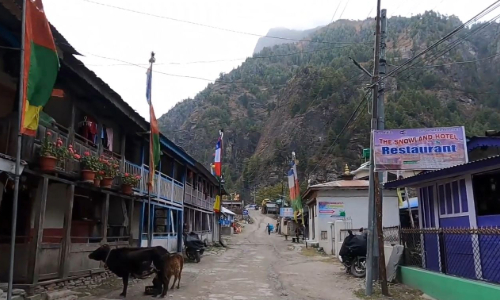
The major source of earning money is collecting Yarsagumba. Also, most of the people are engaged in running the teahouses and tourism business. You can even get to have fresh apples in the area.
Teahouses in Koto:
- There are around 20 teahouses in Koto.
- Teahouses are really comfortable, and they have a variety of services.
- You will find Wi-Fi, a hot shower, charging, mobile networks, and a really comfy room.
[NOTE: You do not need to pay any extra charge in Koto.]
Meal : Breakfast, Lunch and Dinner
Accommodation : Tea House
Walking / Driving : 10 hours driving
Day 02: Trek from Koto to Meta
Trek Route: Koto → Meta
Beginning Point: Koto (2600 m/8530 ft.)
Ending Point/Overnight: Meta (3625 m/11893 ft.)
Lunch: Teashop on the way
Koto to Meta Distance: 14.5 km/ 9 miles
Total Descent: 290 m/ 951 ft.

On this second day, after having breakfast around 8 in the morning, we will start heading towards our today’s destination, which is Meta. The route to Meta is somewhere flat, somewhere uphill, and one portion of the route even has a roadway. Most of the way is jungle road.
After walking for around 3 hours, we will reach our lunch place. The place has two teashops, which are just for lunch and having tea and coffee. After having lunch, we will again trek for around 4 hours and reach Meta.
About Meta:
Meta is a teahouse area, and it does not have local residential houses. You can enjoy some beautiful mountains from Meta. There is also a police check post in Meta where your permits will get checked.
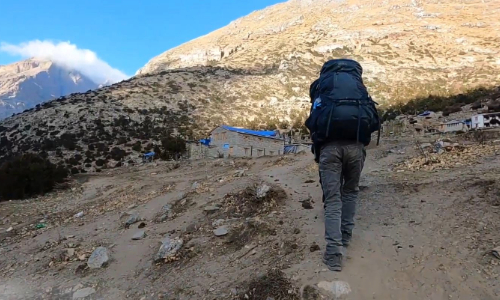
About Teahouses in Meta:
- There are around 10-12 teahouses in Meta.
- There are services of Wi-Fi, hot shower, mobile networks and comfortable accommodation.
- You will get local and some essential Western foods.
[NOTE: You will need to pay an extra Rs.500 for the hot shower and Rs. 500 for Wi-Fi usage but do not need to pay for charging.]
Meal : Breakfast, Lunch and Dinner
Accommodation : Tea House
Walking / Driving : 7 hours
Day 03: Trek from Meta to Phu Gaon
Trek Route: Meta → Chyako → Kyang → Phu Gaon
Beginning Point: Meta (3625 m/11893 ft.)
Ending Point/Overnight: Phu Gaon (4100 m/13451 ft.)
Lunch: Kyang
Meta to Phu Gaon Distance: 16.5 km/ 10.2 miles
Maximum Elevation: Phu Gaon (4100 m/13451 ft.)
Total Ascent: 475 m/ 1558 ft.
On this day, we will make our way to the Phu Gaon. The path today is dry and rocky. On the way to Phu Gaon, we will find many other villages in the region, such as Chyaku and Kyang.
It will take around 6-7 hours to reach Phu Gaon on this day. The path is very rocky and has rivers along the way. Today, the path has a gradual ascent. The landscape is parched and arid. You can see a clear view of the Annapurna range and Himlung Himal from the area.
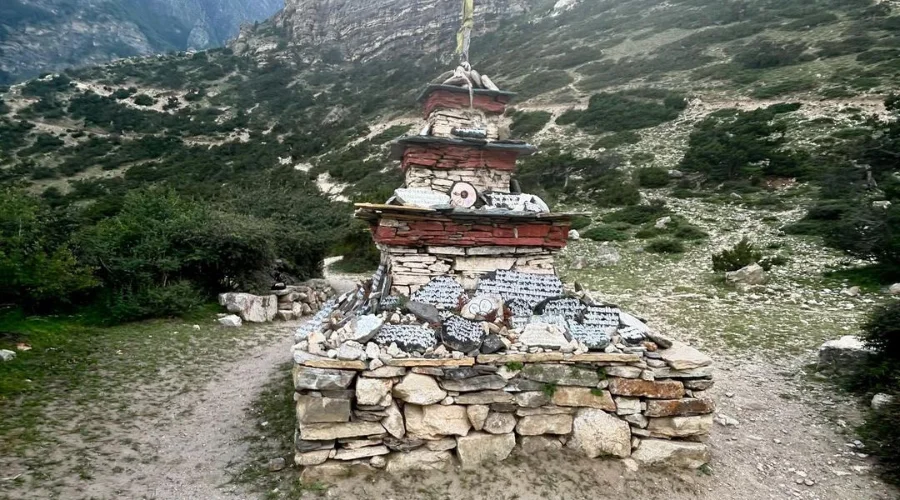
Phu Gaon in Brief | Rest Place of Nar Phu Trek
Phu Gaon is a big village situated in the Annapurna region of Nepal. There are around 50-60 local houses of the people. Most of the people are Sherpa and follow Tibetan culture and traditions. The people of the area are Buddhist.
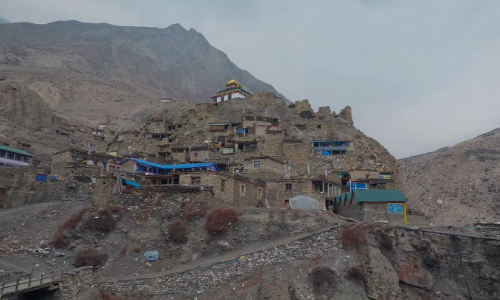
The village is surrounded by breathtaking views of the Himalayas, including peaks like Himlung Himal and Kanguru Peak. It features ancient monasteries such as Tashi Lhakhang, which are central to the local culture.
Trekking to Phu Gaon typically involves navigating through rugged terrains and lush forests, providing trekkers with a serene experience away from the more crowded trails of the Annapurna region.
About Teahouses of Phu Gaon:
- There are around 7-8 teahouses in Phu Gaon.
- There is no electricity or WIFI in the area.
- Hot showers and mobile towers are also available in the area.
- You will find local Nepali food along with some Western foods.
[NOTE: You will need to pay Rs.300 for charging and for a hot shower Rs.500.]
Meal : Breakfast, Lunch and Dinner
Accommodation : Tea House
Walking / Driving : 8 hours
Day 04: Acclimatization Day at Phu Gaon (Hike to Himlung Himal Base Camp)
Hike Route: Phu Gaon → Himlung Base Camp → Phu Gaon
Beginning/ Ending Point/Overnight: Phu Gaon (4100 m/13451 ft.)
Lunch: Himlung Base Camp (Packed Lunch)
Maximum Elevation: Himlung Base Camp (4540 m/14895 ft.)
Total Descent: 440 m/ 1443 ft.
On this rest day, we will only partially rest; we will hike up to Himlung Base Camp, which is situated at 4540 meters. We will hike for around 6 hrs around the trip.
The way from Phu to Himlung Base camp is not easy as we think. We can also encounter glaciers on the way. It will take around 4 hours to reach the base camp.
Since there are no places on the way to have lunch, we will take a packed lunch with us. Also if anyone wants to stay at the base camp itself then they must carry the tenting equipments for camping.
Since there are no any teahouses in the Himlung Base Camp we will not stay there. We will return back to Phu village this day after exploring.
We will need 2 hours to return to the place and rest in our same cozy teahouse.
Meal : Breakfast, Lunch and Dinner
Accommodation : Tea House
Walking / Driving : 5-6 hours
Day 05: Trek to Nar Phedi from Phu Gaon
Trek Route: Phu Gaon → Kyang → Chyako → Nar Phedi
Beginning Point: Phu Gaon (4100 m/13451 ft.)
Ending Point/Overnight: Nar Phedi (3490 m/11450 ft.)
Lunch: Nar Phedi
Phu Gaon to Nar Phedi Distance: 10 km/ 6.2 miles
Maximum Elevation: Phu Gaon (4100 m/13451 ft.)
Total Descent: 610 m/ 2001 ft.
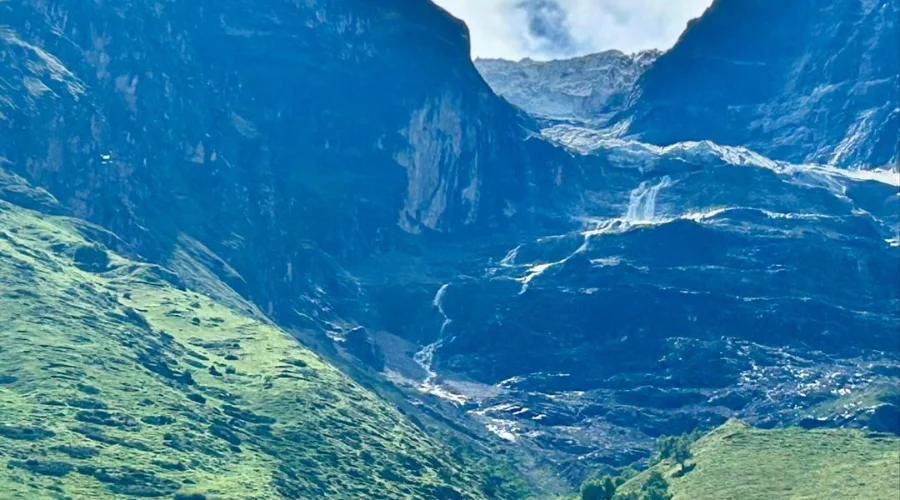
Today, we have to make our way up to Nar Phedi. It will take around 5 hours to reach Nar Phedi from Phu Gaon. The route has a gradual descent as we move towards the low altitude.
First, we re-trace our original route to Meta. Then, we take a different route leading us to the Nar Phedi monastery. This monastery is actually our accommodation for the night.
We stay with the welcoming nuns and join them in the Kitchen. We plan to join the nuns at the Puja session in the evening. It’s a very rewarding stay in the mountains.
Brief About Nar Phedi | Monastery Village of Nepal
Nar Phedi is actually a monastery place where all your accommodation will be done. It is said that the monastery was built 600-700 years ago.
Many monks reside in the monastery and learn Buddhism. Around 100 people can be accommodated in the monastery. The monastery also consists of cooks who will help you have delicious food in the Nar Phedi monastery.
There are no teahouses in Nar Phedi, but you will still get maximum facilities in the monastery. There are rooms, electricity, a hot shower, and an NTC mobile tower.
Meal : Breakfast, Lunch and dinner
Accommodation : Tea House
Walking / Driving : 5-6 hours
Day 06: Trek to Nar Village from Nar Phedi
Trek Route: Nar Phedi → Nar
Beginning Point: Nar Phedi (3490 m/11450 ft.)
Ending Point/Overnight: Nar (4110 m/13484 ft.)
Lunch: Nar
Nar Phedi to Nar Village Distance: 8 km/ 4.9 miles
Maximum Elevation: Nar (4110 m/13484 ft.)
Total Descent: 620 m/ 2034 ft.
On the sixth day of the trek, you do not have to walk much. It is just 3 hrs trek. There are no such major highlights in the region. The path is very dry and rocky. As it is a short-duration trek, we will have our lunch after reaching Nar Village.
Brief About Nar Village | Region of Sherpa & Tibetan
Nar village is a big village in the remote and restricted area of Nepal. There are around 100 local houses of the people. Most of the people residing in the region are Sherpa and Tibetan. The houses are made up of really different designs. It seems like one house is just made at the top of the other and so on.
The major source of income for the people is agriculture; they grow wheat and buckwheat. Most of them are also engaged in running teahouses and in tourism. The local people also raise cattle, such as yaks, cows, and sheep.
There is an old monastery in the region, which we can explore after having lunch and resting for a while.
About Teahouses of Nar Village:
- Around 20 teahouses in Nar Village.
- There is wifi, a hot shower, battery charge, and single-room services.
- You will find the attached bathroom in the area. Also, the charging plugs are in the room.
[NOTE: You must pay an extra charge for the above services.]
Meal : Breakfast, Lunch and Dinner
Accommodation : Tea House
Walking / Driving : 3 hours
Day 07: Trek to Ngawal from Nar via Kang La Pass
Trek Route: Nar → Kang La Pass→ Ngawal
Beginning Point: Nar (4110 m/13484 ft.)
Ending Point/Overnight: Ngawal (3660 m/12007 ft.)
Lunch: Packed Lunch Kang La Pass
Nar to Ngawal Distance: 14 km/ 8.69 miles
Maximum Elevation: Kang La Pass (5320 m/17454.07 ft)
Total Descent: 450 m/ 1476 ft.
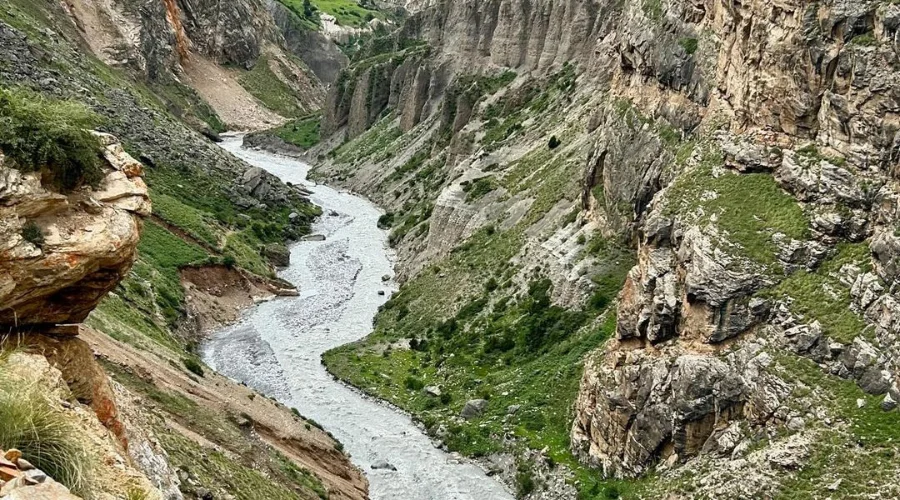
This is going to be a really long and hard trek among the al days of Nar Phu Valley Trek. We need to make our way to the high pass, Kang La Pass, on this day.
It takes around 5-6 hours to reach Kang La Pass from Nar village. The route up to the Kang La Pass is steep as we will be going to gain a high altitude. Kang La Pass is situated at an altitude of 5320 meters. We can see the whole Annapurna range, Himlung Himal, and even Humde Airport in Manang from the high pass.
We will have a packed lunch on this day and have lunch at the Kang La Pass. After resting for a while, we will make our way to Ngawal. During the winter season, it is really hard to pass the Kang La Pass because of the heavy snowfall and steep descent while moving to Nawal.
It takes around 3-4 hours to reach Ngawal from Kang La Pass. We will stay at Ngawal’s teahouse.
Ngawal | A Small Village in the Annapurna Region
Ngawal or Nawal is a small village situated in the Annapurna region of Nepal. Around 40-50 local houses of Sherpa and Tibetan can be seen in Ngawal. The majority of the people are involved in collecting Yarshagumba. The remaining people are engaged in running teahouses in the area to serve local and international tourists.
About Teahouses in Ngwal:
- There are 10-12 teahouses in Ngwal.
- There are comfortable teahouses with wifi facilities, hot showers, attached bathrooms, and everything.
[NOTE: You must pay an extra charge for the above services.]
Meal : Breakfast, Lunch and Dinner
Accommodation : Tea House
Walking / Driving : 8 hours
Day 08: Drive to Besisahar from Ngawal
Drive Route: Ngawal → Besisahar
Beginning Point: Ngawal (3660 m/12007 ft.)
Ending Point/Overnight: Besisahar (760 m/2593 ft.)
Lunch: On the way
Ngawal to Besisahar Distance: 60.2 km/ 37.4 miles
Maximum Elevation: Ngawal (3660 m/12007 ft.)
Total Descent: 2900 m/ 9514 ft.
As Ngawal has a direct connection to the road, we will take a Jeep from Ngawal to Beshisahar. The bus cannot reach Ngawal, so there is a jeep in the area. Bikes can be reached up to the area.
We will have our lunch on the way. It will take around 6-7 hours to reach Beshisahar. Most of the parts of the road are off-road. Only up to 10 km of the area is pitched.
You will find a dry and desert-like road on the way to Besisahar. After reaching Besisahar, we will stay at the hotel there.
Brief About Besisahar | Gateway of Annapurna Circuit
Besishahar is a municipality in Nepal’s Lamjung District, known for its stunning views and for being the gateway to the Annapurna Circuit.
The town is home to around 38,000 people, primarily from the Gurung ethnic group, along with other communities. Residents engage mainly in agriculture, trade, and services, creating a vibrant mix of rural and urban life.
Its friendly atmosphere and rich culture make Besishahar a welcoming place for both locals and visitors.
About Hotels in Beshisahar:
- There are many hotels and lodges in Besisahar.
- You will find really comfortable and standard hotels.
- All facilities like wifi, electricity, charging, and hot showers can be found in the hotels.
[NOTE: You do not need to pay any charge for these services.]
Meal : Breakfast, Lunch and Dinner
Accommodation : Guest House
Walking / Driving : 6-7 hours driving
Day 09: Drive back to Kathmandu from Besisahar
Drive Route: Besisahar → Malekhu→ Kathmandu
Beginning Point: Besisahar (760 m/2593 ft.)
Ending Point/Overnight: Kathmandu(1400 m/4593.17 ft.)
Lunch: Malekhu
Besisahar to Kathmandu Distance: 176 km/ 109.3 miles
Maximum Elevation: Kathmandu(1400 m/4593.17 ft.)
Total Descent: 640 m/ 2099 ft.
Driving from Besisahar to Kathmandu, approximately 176 kilometres (109.3 miles), typically takes 6 to 8 hours, depending on traffic and road conditions.
The route primarily follows the well-maintained Prithvi Highway with stunning views of lush green hills, valleys, and rivers, including the Marshyangdi River.
As you drive, you’ll experience a blend of rural Nepalese culture and breathtaking mountain vistas, especially of the Annapurna range, on clear days, making this journey not just a means of transport but a memorable scenic adventure.
Hotels in Kathmandu:
- In Kathmandu, there are various options where you would like to stay.
- From standard to luxurious hotels, you will find all.
- They will provide you with the best comfort and all the services you need.
Meal : Breakfast and Lunch
Accommodation : Not Included
Walking / Driving : 6-7 hours driving
include / exclude
Trip Cost Includes
- International Airport Pickup and Drop off by private car.
- Nar Phu Trek Local guide for 9 days.
- Annapurna conservation Area Permit and Nar Phu Valley Restricted Permits.
- Kathmandu to Besishar by local bus.
- Besishar to Koto by local jeep.
- Nagwal to Besishar by local jeep.
- Besishar to Kathmandu by local bus.
- One set of breakfast, one set of lunch, one set of dinner, tea and coffee on the trek.
- Best available tea house accommodation during the trekking days.
- Company Service Charges and local tax.
Complimentary services from Himalayan Masters
- Himalayan Masters brand -25 Degrees Celsius sleeping bag during the trip if needed.
- Himalayan Masters Brand 25 Degrees Celsius down jacket during the trek, if needed.
- Trekking poles during the trek if needed.
- Use a pulse oximeter to check your SpO2 and bpm at high elevations.
- 1 litre BPA- Free plastic water bottles and purification tablets.
- First-aid kit box.
- Updated Nar Phu Valley Trek Map.
- Seasonal fruits for dessert.
- The Himalayan Masters brand duffle bag for the trip.
- Himalayan Masters Brand Trekking T-Shirt and Cap.
- One bottle of oxygen is carried by the guide for an emergency.
- You can store your stuff in our office at Thamel, Kathmandu.
Trip Cost Excludes
- International Flight Ticket.
- Nepal visa fees.
- Hotels in Kathmandu.
- Food in Kathmandu.
- Porter charges for the trek.
- Private transportation.
- Tips for guide.
useful info
Best Time for Nar Phu Valley Trek
Nar Phu Trek can be considered best in spring, autumn, and monsoon seasons. Also, since it is a dry place, monsoons will not significantly affect the climate there. However, one should avoid the trek in winter as it snows heavily, which makes it difficult.
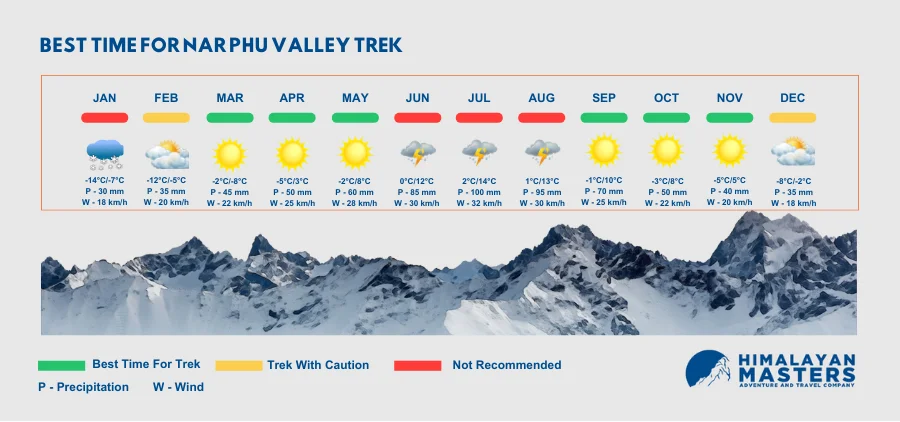
Autumn Season:
Autumn extends from September to November and is generally considered an ideal time for trekking. Due to the clear weather and excellent views, this is regarded as one of the best seasons for any trekking. This is a slightly warm season, so long hikes can occur without disturbance.
Spring Season:
Spring, starting from March and extending to May, is another favourable time. This offers a kaleidoscope of colours due to the blooming of various flowers on the way. The climatic conditions are quite warm, with partial or no rainfall.
Winter Season:
Winter falls between December and February, and it is pretty cold and demanding. It could block pathways due to snow, but trekkers in that cold will find awesome winter landscapes with fewer people.
Summer/Monsoon Season:
The summer season starts in June and lasts until August. Heavy rains during these months make the trek difficult because of slippery trails and possible landslides. You are not advised to go trekking in Nar Phu Valley during the monsoon season.
Documentations to Book Nar Phu Trekking
- Valid Passport
- Passport Sized Photo
- Annapurna Conservation Area Permit – ACAP
- Special permit for Nar Phu
- Travel Insurance
Experience of Nar Phu Trekking
The Nar Phu Trekking experience is unique and rewarding. It takes trekkers through remote valleys with breathtaking landscapes and rich local culture. Along the way, you will meet friendly villagers who add a personal touch to your journey.
The trail winds past ancient monasteries and traditional Tibetan homes. This creates a sense of wonder as you explore the area. Each day brings new adventures and stunning views. It is a memorable experience for everyone who ventures into this beautiful part of Nepal.
Weather of Nar Phu Trek
Weather conditions around Nar Phu Valley vary greatly throughout the year. It is perfect for trekking in autumn due to the clear skies and mild temperatures. During spring, different wildflowers bloom, and the weather is pleasant, though there are sudden on-and-off rains.
Winters can get pretty cold with snowfall even, making trekking pretty difficult. During summer, heavy monsoon rains make the trails hard and slippery.
Nar Phu Trekking Difficulty
Nar Phu Trek is graded from moderate to challenging since a trekker requires a good fitness level and stamina, as this trek revolves around different altitudes and has numerous ups and downs.

Some trekking routes for Nar Phu Valley are steeply up, and others are steeply down, giving exhaustive efforts to the trekkers. Thus, one must be prepared for continuous walking without exhaustion; however, this trek is achievable for a reasonably fit and well-prepared person.
People Also Like This: Annapurna Death Rate
Trek Route to Nar Phu Valley
Once you reach Kathmandu, the adventure for Nar Phu Valley begins. At Tribhuvan International Airport, you will see Himalayan Masters representative will have someone there to greet you.
After that, you will be taken to your hotel in Thamel, where the action in Kathmandu is concentrated for tourists. Our team will give a clear briefing about the trek, depending on when you arrive, either at your hotel or at our office in Thamel, Kathmandu.
This session is about learning the path you’ll take, how to stay safe and how to organize your gear.
We’ll head out by driving to Koto or Dharapani from Kathmandu on the day you are ready, depending on the state of the roads at the time. Starting from here, the main trekking experience happens.
While on the journey, you’ll hike through dense woodlands, go through tight canyons and visit old villages, ending up in Nar and Phu.
The Nar Phu Trek route goes steadily higher, allowing for getting used to the higher altitudes and for exploring on your way up to the high Kang La Pass.
Road on the Trek & How to Avoid
Most Nar Phu Trek Route roads are just high, rough roads without tar. To avoid hazards, one must walk on the marked trails and do what your guide says. Be careful about the loose rocks and slippery sections after rain. Proper footwear is essential as it helps trek the rough terrain safely.
You can also reach Annapurna Circuit Trek via Nar Phu Valley.
Special Training for Nar Phu Valley Nepal
If you are not a regular hiker, you should take special training for the Nar Phu Valley Trek. The training should focus on cardiovascular fitness, muscle strengthening, and endurance.
Hiking on different types of terrain will help you get in shape for the trek. You can also climb stairs and take long walks during your training. Carrying a backpack will also be helpful in simulating trekking.
Altitude Sickness in Nar Phu Valley
Basic risks on the Nar Phu Trek include altitude sicknesses, including headaches, nausea, and dizziness, as the elevation is relatively high at 5320 meters, Kang La Pass.
Hence, proper acclimatization shall be done to reduce any risk. Go at a leisurely trek pace, drink plenty of water, and listen to your body. If symptoms persist, it is essential to descend to a lower altitude.
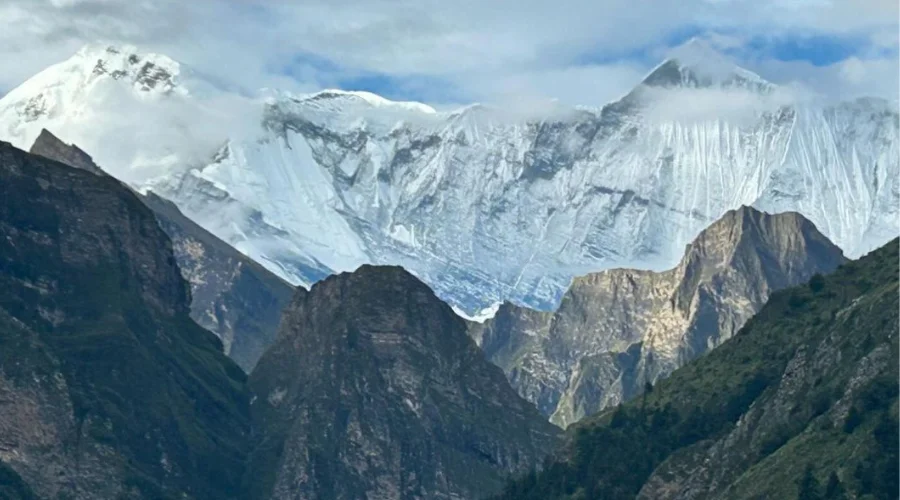
Emergency and Evacuation on the Trek
It is always good to be prepared for emergencies that might call for your quick evacuations on the Nar Phu Trek. Also, a helipad in Meta, Phu, and Kyang will help with helicopter evacuation.
While guides are trained for this, it is always essential to have a personal plan. Communication devices will help in contacting rescue services. A first-aid kit and some basic knowledge of first-aid procedures are also paramount.
Nar Phu Travel Insurance
Nar Phu Trek travel insurance is highly recommended. It covers medical emergencies, cancellations, and evacuations. Make sure to seek policies related to trekking and high-altitude activities. World Nomads and Allianz are the two most well-known insurance providers, which provide comprehensive coverage to adventure travellers.
Other Expenses
Additional Nar Phu Trek costs apart from the trek’s price include further tips for the guides and porters, snacks, drinks, personal gear, and options such as hot springs or cultural activities. It is a good idea to have an extra budget of around $200-$300 during your trek for these extra expenses.
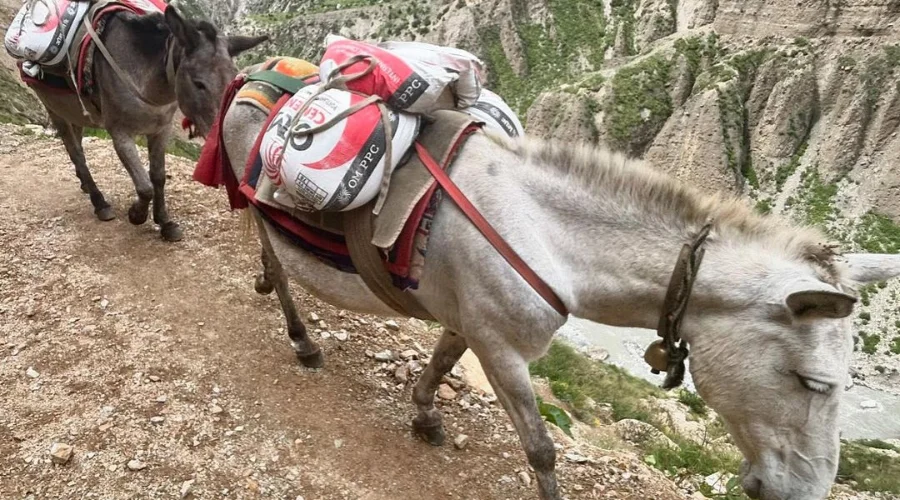
ATMs on the Trek Route
The last ATM stop en route to Nar Phu Trek is in Chame, the district headquarters. It is best to withdraw sufficient cash here while one has access to ATMs since there won’t be any available in Nar Phu Valley.
Money Exchange in Kathmandu and Pokhara
You will find several money-changing shops in Kathmandu and Pokhara. The rates are competitive, and you can change cash or traveller’s checks. ATMs accept international cards in the same cities, thus making another convenient option to get Nepali rupees.
Packing List for Nar Phu Valley Trek
Clothing
- Base Layers (thermal tops)
- Trekking Shirts (moisture-wicking)
- Fleece Jacket
- Down Jacket
- Waterproof Jacket
- Trekking Pants (quick-dry)
- Thermal Long Johns
- Waterproof Pants
- Woolen Cap
- Sun Hat
- Scarf or Bandana
Handwear
- Lightweight Gloves
- Heavyweight Winter Gloves
- Hiking Gloves
Footwear
- Hiking Boots (ankle support)
- Hiking Sandals
- Hiking Socks (woolen or moisture-wicking)
Additional Essentials
- Sleeping Bag (suitable for low temperatures)
- Sleeping Mat
- Trekking Poles
- Backpack (minimum 50 liters)
Personal Items
- Sunscreen and Lip Balm (high SPF)
- Personal Hygiene Items
- Ear Plugs and Eye Mask
- Sanitary Supplies
Accommodation on Nar Phu Valley
For Kathmandu and Pokhara, we will be staying in a 3-star hotel. The rooms will have a free private bathroom, hot shower, Wi-Fi, and electricity. However, you will stay in the local guesthouse called tea houses on the trek. Locals run these tiny wooden homes along with different places on the Nar Phu Valley trek map.
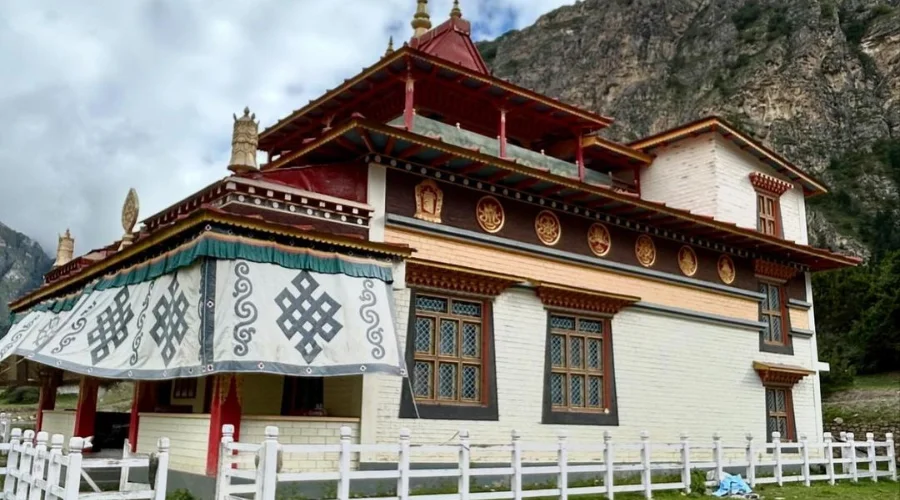
They provide rooms with two or three twin beds, a mattress, and a small blanket (you should carry a sleeping bag). A private bathroom is unavailable for the trek, and you should use the common bathroom. Hot showers, Wi-Fi, and electricity are available in Nar and Phu Valley but will cost a few dollars.
Food on the Trek
You will have the following foods on the Narphu Valley trek.
Breakfast: Generally, options are provided, such as porridge, pancakes, or eggs with bread. Tea or coffee is provided to stir you up.
Lunch: For lunch, either dal Bhat (lentil soup with rice), noodles, or momos. You will feel full enough.
Dinner: In most cases, it is similar to lunch with vegetable curry, rice, and occasional meat items. Fruits or some local sweets may be included in desserts.
Electricity & Battery Recharge During the Trek
Electricity Availability of electricity on the Nar Phu Trek: Teahouses in Koto and Phu have electricity. Charging your devices at an average of $2-3 is a small charge. You will find that there are solar panels everywhere, especially in the remotest parts, where charging can be done on a very limited scale.
Water on Nar Phu Trek
Water purification tablets are provided free of cost by Himalayan Masters during the trek. It is essential to hydrate your body well in any trek. You can fill up your water bottles from any teahouse, and using these tablets ensures purified drinking water.
Communication on Nar Phu Valley Trek
The various ways to communicate on Nar Phu Trek are:
SIM Card: You may purchase a local SIM card in Kathmandu. It accesses almost all the areas.
Landline/Post: A few teahouses have landline phones for emergencies, but one should have a low expectation.
Walkie-Talkie: Guides may be using walkie-talkies for communication during the trek.
Wifi/Internet: Very few teahouses have limited wifi, which usually needs to be faster. You don’t get wifi in most places.
Safety and Security
Safety on the Nar Phu Trek is paramount. Remember, it falls into a restricted area trek, so trek only with a registered guide for safety. Pay attention to your guide’s recommendations, use only the marked trails, and pay attention to rapidly changing weather conditions. Bring along a first-aid kit and inform others of your schedule.
Guide Versus Solo Trekking
Nar Phu Valley Trek solo is restricted since Nar Phu is a restricted area of Nepal. You have to be accompanied by a licensed guide. This will promise your safety and offer you some valuable insights regarding the culture and environment of the region.
Porters Versus No Porter
While on the Nar Phu Trek, one strongly recommends finding and hiring a porter. In this way, you can easily let a porter be in charge of your heavy gear so that you can focus on the trek itself.
Not only does it improve your overall experience, but it also benefits the local economy as a whole. If you do not hire one, be ready to carry your backpack.
How to Hire a Porter
It would help if you considered the following tips when it comes to hiring a porter for the Nar Phu Trek:
- Check their experience and qualifications.
- Negotiate the daily pay in advance; $20-25 seems a good average amount.
- Ensure they are correctly kitted out with proper equipment and clothes.
- Negotiate the maximum weight they can carry.
Tipping Culture for Guides and Porters
It is customary to tip in Nepal, especially guides and porters. A normal tip can be from $10 to $20 per day for guides and from $5 to $10 for porters, working on a tipping culture based on good service.
It is a way of appreciation for the effort and assistance they have given you. Also, make up your mind that the Nar Phu trek without guide is impossible for tourists.
Alternative Nar Phu Trek Routes
Other trekking routes to Nar Phu Valley are the Kang La Pass trek and Annapurna Circuit. On these routes, you get equally spectacular views with some different experiences. Besides these routes, there are no trekking routes to reach Nar Phu Valley Trek.
Extending Trip
You are also free to extend the trip around the vicinity, go to Manang, or go on another trek like the Tilicho Lake Trek. For an extended trip, one can always check into other areas of Nepal, such as Ghorepani Poon Hill Trek and Langtang Valley Trek.
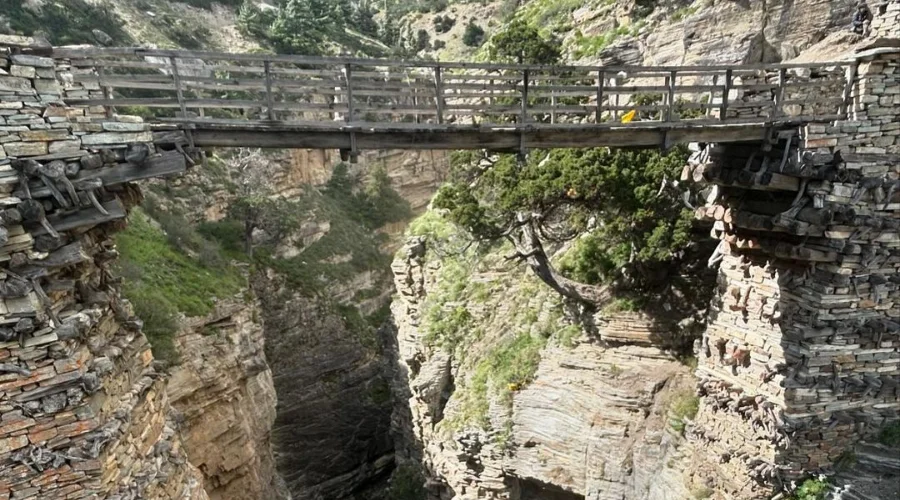
How do you book Nar Phu Valley Trek with Himalayan Masters?
Nar Phu Trek can be booked through any agency for trekking in Kathmandu or Pokhara. Several agencies offer package deals with permits, guides, and accommodations. It’s best to book this in advance because the peak trekking seasons are quite busy.
How Can I Book at the Last Minute?
One can visit the trekking agencies in Kathmandu or Pokhara for last-minute bookings. Most of them entertain last-minute reservations during the trekking seasons. One should also be prepared to bargain on prices and ensure all permissions are handled.
Why Choose Himalayan Masters?
Choosing Himalayan Masters will guarantee an organized, safe trekking adventure. The agency has skilled guides who handle their guests’ safety and enjoyment needs. They provide full support with permits and accommodation so that you can focus on the Nar Phu Trek ahead.
Feedback/Review
Himalayan Masters seek feedback and reviews from those who have trekked with them. Himalayan Masters tries to improve the feedback given by our trekkers.
Reviews
I did the Nar Phu Valley trek in May 2025 with Himalayan Masters, and it was one of the best trekking experiences of my life. Our guide, Govinda, was knowledgeable, caring, and made sure we were safe and comfortable throughout the journey. Subash, our porter, was also incredibly supportive and always had a smile on his face.
The remote villages, mountain views, and peaceful trails were unforgettable. I highly recommend Himalayan Masters for anyone planning a real Himalayan adventure!
Maddie SmithAustralia
Trekking to Nar Phu Valley with Himalayan Masters in May 2025 was a once-in-a-lifetime experience. Our guide, Kanchan, was professional, patient, and full of interesting stories about the region. Porter Nabu was so kind and helpful throughout the journey.
The trail was peaceful, the villages were full of culture, and the views were absolutely breathtaking. I felt safe, well taken care of, and truly connected to the mountains. Highly recommend this team!
Siam SalterUK
We had the most wonderful experience with Himalayan Masters doing a combined trek of Manaslu + Nar Phu. We were guided by two great guides, one senior, one soon-to-be guide, with whom we had great fun, also on the difficult parts of the hike.
Victoria dUSA
FAQs
Why trek to Narphu valley with Himalayan Masters?
First and foremost, Himalayan masters have been offering excellent trekking packages throughout Nepal, and the trekkers love our service. We always keep our trekker’s comfort and safety in the utmost position.
Next, since Nar and Phu Valley are restricted regions of Nepal, you will need a trusted agency to get the Nar Phu Trek permits and guidance.
We will help you book the rooms and get all those permits during an emergency. Everything will be neatly arranged while you are busy making beautiful memories. That’s why you should take our Nar Phu trek package.
How difficult is the Nar Phu trek?
Will I have internet/ Wi-Fi in Nar Phu Valley Trek?
How much extra personal expenses do I need for this trek?
How do I withdraw cash in Nepal?
What should I pack for Nar Phu trek?
Where is the Nar Phu Valley Trek?
How long does the Nar Phu Valley Trek typically take?
What is the highest altitude reached on the Nar Phu Valley Trek?
What permits are required for trekking in Nar Phu Valley?
When is the best time to do the Nar Phu Valley Trek?
Can I trek independently in Nar Phu Valley, or do I need a guide?
What types of accommodation are available along the trek?
Is altitude sickness a risk during the Nar Trek?
What kind of scenery can I expect while trekking in Nar Phu Valley?
Can I combine the Nar Phu Valley Trek with other trekking routes in Nepal?
How do I get to the starting point of the Nar Phu Valley Trek?
Are there any specific health precautions I should take before trekking?
What kind of food is available during the trek?
How do I stay connected while trekking in remote areas like Nar Phu Valley?
Speak to an Expert





Sandip Dhungana
Nepal 🇳🇵
Whatsapp: +977-9823636377
Speak to an Expert





Sandip Dhungana
Nepal 🇳🇵
Whatsapp: +977-9823636377


